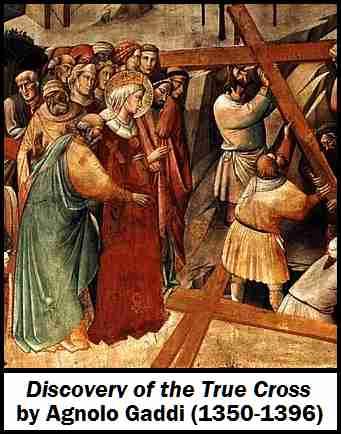
The True Cross
The cross on which Jesus died is called the True Cross. According to Christian tradition, it disappeared after the crucifixion, but was found again about three centuries later during a search in Jerusalem. Parts of it were eventually taken to other places, and many modern churches claim to have small pieces of the wood. Some people believe that this wood has miraculous healing powers.
The bible doesn't say what happened to the cross after Jesus was removed from it. Some Christians claimed later that the Jews had hidden it, but this is unlikely. In fact, no reliable reports of its whereabouts appeared for almost three hundred years. Then finally, according to church historians, it was discovered in Jerusalem in the year 326 AD by Empress Helena, the mother of Constantine the Great.
The Empress went to the city in that year to search for Jesus' tomb and the location of Golgotha (the place where he was crucified). The historical descriptions of her search differ in some ways, but they all agree that she successfully identified both locations, and also found three crosses in the same area. She quickly concluded that these were the crosses used to crucify Jesus and the two men put to death with him. But initially she didn't know which one was the true cross.
There are slightly different accounts of how the Empress determined which cross was the correct one. According to a book called the Acts of Judas Cyriacus, the crosses were laid (one at a time) on the coffin of a dead youth. The first two crosses had no effect, but the third one instantly brought the youth back to life, thereby proving itself to be the true cross. Another account, by the historian Rufinus, says that the test was performed on a dying woman, who was immediately restored to health when touched by the third cross. Of course it's possible that both tests were done, perhaps with different people as witnesses.
At any rate, in both cases the true cross was easily identified by its miraculous healing power. The usual explanation for this healing power is that it is an intrinsic property of the wood itself, created when the cross was in physical contact with the body of Christ and stained with his blood, sweat, and tears.
After its identification, the true cross was separated into at least two pieces, one of which remained in Jerusalem, while another was taken to Constantinople. But fragments soon began to turn up in many other places. As early as 348 AD, Cyril of Jerusalem said that the "whole earth is full of the relics of the cross of Christ." Even more fragments became available during the Middle Ages after Crusaders found large pieces while plundering conquered cities.
Eventually the wood became so plentiful that some people obtained their own individual pieces, or at least small particles, and kept them inside gold crucifixes which they wore suspended from their necks. Hundreds of churches and monasteries also acquired pieces, many of which are still kept inside reliquaries decorated with gold and jewels.
The existence of so many pieces has led some people to question whether a single cross could have supplied enough wood for all of them. One famous doubter, the Protestant reformer John Calvin, suggested that all the existing fragments, if collected together, would fill a large ship. Some theologians responded to Calvin's charge by asserting that wood from the true cross can miraculously multiply itself, thereby creating whatever amount is required to meet the need. It is also possible that Calvin vastly overestimated the total volume of the surviving fragments, and that a single cross actually could have provided all the necessary wood.
Of course, even if a single cross could have provided enough wood, this doesn't mean that all the surviving pieces are genuine. In fact there is a good chance that many of them are fakes. Some historians believe that dishonest knights brought chunks of ordinary wood back from the crusades and sold them to church officials under the false claim that they came from the true cross. As for the numerous small pieces, many of them were bought from traveling merchants who probably didn't know (or care) where the wood originally came from. Even the cross discovered by Saint Helena might not have been the real true cross. The various accounts of the discovery differ about certain details, and this raises questions about what she actually found.
Even so, many people have believed that at least some of the pieces are genuine. This belief was especially prevalent during the Middle Ages, and new stories about the wood's miraculous healing power appeared throughout that period. One explanation for these stories is that the reported cures were "faith healings" brought about by an extremely strong belief in the power of the wood. Some of these stories could have also been fabrications created to attract pilgrims to the church or holy site where the wood was located.
Reports of modern healings are not very common, possibly because most specimens of the wood are now kept in reliquaries or glass enclosures where they can't be physically touched. Also, many specimens could be fakes, and these obviously wouldn't have any healing power.
Other Mysteries
Note: For more information about this subject, go to this Article about the True Cross.
Contact Email



